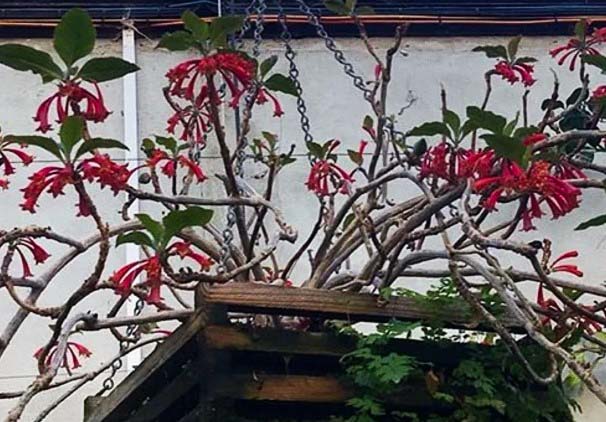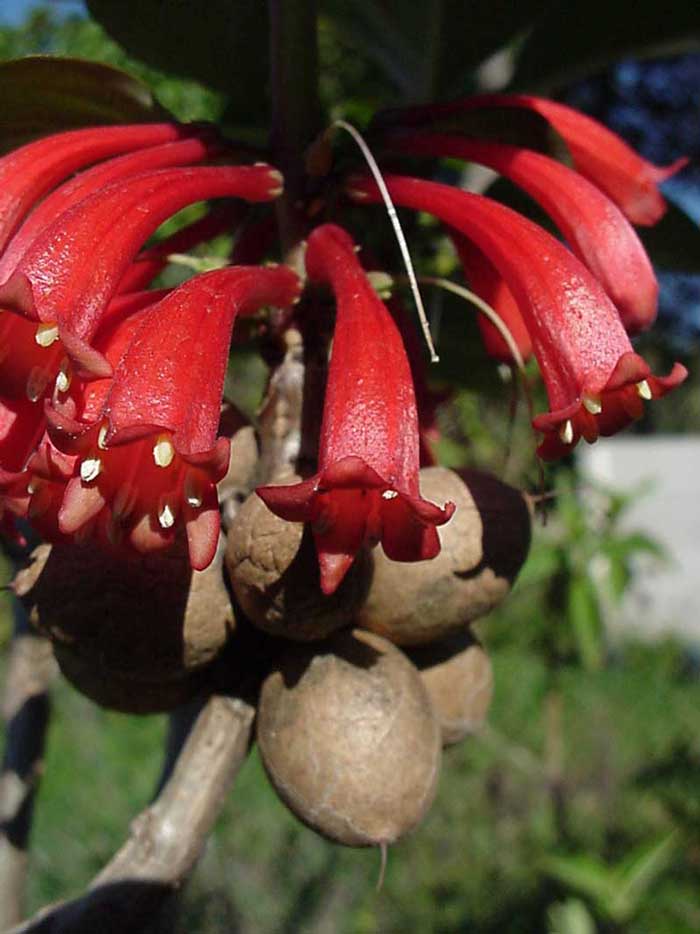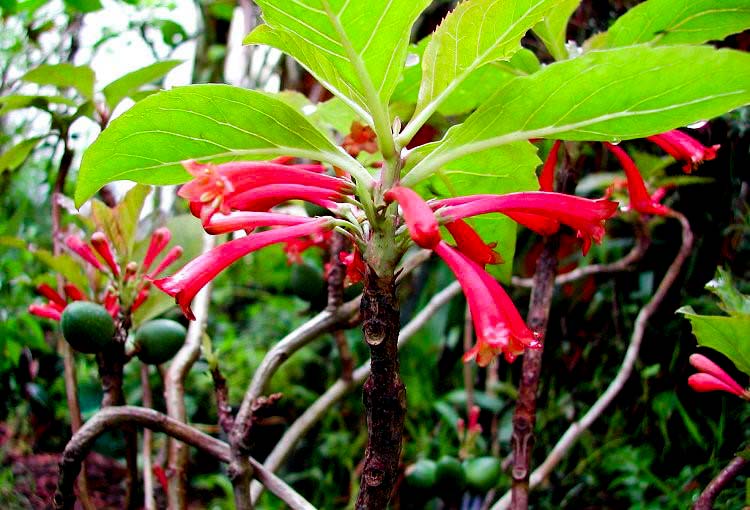Dermatobotrys
saundersii
Dermatobotrys saundersii
Family: Scrophulariaceae
Common names: tree jockey
The genus Dermatobotrys is a member of the snap dragon family (Scrophulariaceae) which is related to the Tree Fuchsia, Halleria lucida. Dermatobotrys has only one species. Seeds sent to Kew in the 1890s germinated well and plants have been grown in cultivation ever since.
Description
Dermatobotrys saundersii is an epiphytic shrublet that can reach one metre in height , which grows in the forks of a variety of trees, on the Pondo Palm or Coconut – Jubaeopsis caffra and occasionally on the forest floor.
Dermatobotrys saundersii. The leaves are soft and fleshy with shallow toothed margins and reddish veins. Under natural conditions the plant is deciduous, losing its leaves in late autumn. The tubular deep red flowers appear from mid-winter to mid-summer (June to December), followed by smooth oval brownish fruit filled with numerous small seeds in a sweetish pulp.
It's an odd member of the Snapdragon family that makes a caudex-like base and terrific flowers. Even without blooms it's a first-rate house plant, with its woody stems and attractive leaves that have an interesting scent when rubbed.
Dermatobotrys saundersii develops thick, woody rhizomes that resemble a caudex. From the base emerges a wavy mass of upright, woody stems, each about up to one meter long. The leaves have a rubbery texture, with new growth that is tinged red or purplish. When rubbed, they have a scent that is hard to describe, but it is sort of like lemon furniture polish! It is not a bad scent, just an unexpected one for a plant.
Distribution and habitat
This rare epiphytic plant is found in coastal scarp forests in South Africa on the Transkei coast on the northern banks of the Mtentu and Msikaba rivers close to the ocean. It also found growing further north in southern Zululand to in the canopy of our coastal forests at Ngoye, Nkandla, Qudeni, Ngome and Gwalaweni.
It is also found in Madagascar.
Ecology
It is likely that this plant with its red tubular flowers is pollinated by sunbirds. The fruit has a most unusual scent, which may attract fruit eating birds and small arboreal mammals, which eat the fruit and distribute the seed.
Growing Dermatobotrys saundersii

These attractive plants are easily grown and make very good container plant subjects in particular when grown in hanging baskets. For best results treat Dermatobotrys saundersii as any other epiphyte, it is however important not to over water. Dermatobotrys saundersii grows best in a loose well drained growing medium with plenty of organic material such as leaf litter, compost or chopped coco nut fibre as sold for growing orchids. If grown outdoors or in a green house in areas prone to eel worm (nematodes) keep the plants off of the ground preferably in hanging baskets to prevent these pests from attacking the roots causing the plants to grow very poorly or in extreme cases killing the plants.
Although Dermatobotrys saundersii will grow in rather heavy shade it will not flower well, it flowers best in medium to partial shade and will tolerate full sun.
Dermatobotrys saundersii will grow indoors in a bright well-lit room or under lights where it will tend to flower at any time of the year.
When grown indoors Dermatobotrys saundersii prefers filtered sunlight or morning sun. Protect it from strong afternoon sun.
I feed frequently at very low concentrations as I do for my orchid plants, usually one quarter or less than the recommended application rate with a variety of feeds, being EasyGro™ Flower and Fruit 3:1:6(46) hydroponic feed distributed by Rolfes Agri, Seagro, Nitrosol, fulvic acid as well as with both black as well as rooibos tea.
Periodically I flush out the pots with clean tap water to remove any buildup of salts or other harmful substances of decay in the growing medium.
Pests and diseases
In the close on 50 years that I have grown Dermatobotrys saundersii I have found them relatively pest free other than being extremely prone to nematode attack if they are placed on the ground.
Flowering
For best flowering results dry the plants off almost completely for two to three months in winter to let them rest as in their natural habitat. Your rewarded will be a mass of flowers just before the new leaves appear.
Propagation

For propagating small numbers of plants Dermatobotrys saundersii grows
easiest from cuttings preferably taken in summer which grow extremely
easy placed directly into growing medium, sharp sand of a mix of sharp
sand and peat.
For growing a large number of plants one would need to grow them from seed, I have had best results growing them on peat.
The delicate quick growing seedlings are very prone to damping off so they should be treated with a suitable fungicide at the time of planting the seed then periodically thereafter as per the instructions on the label. I have always successfully used Benlate active ingredient benomyl and Previcur active ingredient Propamocarb as a mixture to control damping off. The seedlings can be prepicked out into individual small containers from a height of 25 mm. Do not over pot. Repot into the next sized container only when they have outgrown the one that they are in.
The seedlings should flower in their second year.
Family: Scrophulariaceae
Common names: tree jockey
The genus Dermatobotrys is a member of the snap dragon family (Scrophulariaceae) which is related to the Tree Fuchsia, Halleria lucida. Dermatobotrys has only one species. Seeds sent to Kew in the 1890s germinated well and plants have been grown in cultivation ever since.
Description
Dermatobotrys saundersii is an epiphytic shrublet that can reach one metre in height , which grows in the forks of a variety of trees, on the Pondo Palm or Coconut – Jubaeopsis caffra and occasionally on the forest floor.
Dermatobotrys saundersii. The leaves are soft and fleshy with shallow toothed margins and reddish veins. Under natural conditions the plant is deciduous, losing its leaves in late autumn. The tubular deep red flowers appear from mid-winter to mid-summer (June to December), followed by smooth oval brownish fruit filled with numerous small seeds in a sweetish pulp.
It's an odd member of the Snapdragon family that makes a caudex-like base and terrific flowers. Even without blooms it's a first-rate house plant, with its woody stems and attractive leaves that have an interesting scent when rubbed.
Dermatobotrys saundersii develops thick, woody rhizomes that resemble a caudex. From the base emerges a wavy mass of upright, woody stems, each about up to one meter long. The leaves have a rubbery texture, with new growth that is tinged red or purplish. When rubbed, they have a scent that is hard to describe, but it is sort of like lemon furniture polish! It is not a bad scent, just an unexpected one for a plant.
Distribution and habitat
This rare epiphytic plant is found in coastal scarp forests in South Africa on the Transkei coast on the northern banks of the Mtentu and Msikaba rivers close to the ocean. It also found growing further north in southern Zululand to in the canopy of our coastal forests at Ngoye, Nkandla, Qudeni, Ngome and Gwalaweni.
It is also found in Madagascar.
Ecology
It is likely that this plant with its red tubular flowers is pollinated by sunbirds. The fruit has a most unusual scent, which may attract fruit eating birds and small arboreal mammals, which eat the fruit and distribute the seed.
Growing Dermatobotrys saundersii

These attractive plants are easily grown and make very good container plant subjects in particular when grown in hanging baskets. For best results treat Dermatobotrys saundersii as any other epiphyte, it is however important not to over water. Dermatobotrys saundersii grows best in a loose well drained growing medium with plenty of organic material such as leaf litter, compost or chopped coco nut fibre as sold for growing orchids. If grown outdoors or in a green house in areas prone to eel worm (nematodes) keep the plants off of the ground preferably in hanging baskets to prevent these pests from attacking the roots causing the plants to grow very poorly or in extreme cases killing the plants.
Although Dermatobotrys saundersii will grow in rather heavy shade it will not flower well, it flowers best in medium to partial shade and will tolerate full sun.
Dermatobotrys saundersii will grow indoors in a bright well-lit room or under lights where it will tend to flower at any time of the year.
When grown indoors Dermatobotrys saundersii prefers filtered sunlight or morning sun. Protect it from strong afternoon sun.
I feed frequently at very low concentrations as I do for my orchid plants, usually one quarter or less than the recommended application rate with a variety of feeds, being EasyGro™ Flower and Fruit 3:1:6(46) hydroponic feed distributed by Rolfes Agri, Seagro, Nitrosol, fulvic acid as well as with both black as well as rooibos tea.
Periodically I flush out the pots with clean tap water to remove any buildup of salts or other harmful substances of decay in the growing medium.
Pests and diseases
In the close on 50 years that I have grown Dermatobotrys saundersii I have found them relatively pest free other than being extremely prone to nematode attack if they are placed on the ground.
Flowering
For best flowering results dry the plants off almost completely for two to three months in winter to let them rest as in their natural habitat. Your rewarded will be a mass of flowers just before the new leaves appear.
Propagation

For growing a large number of plants one would need to grow them from seed, I have had best results growing them on peat.
The delicate quick growing seedlings are very prone to damping off so they should be treated with a suitable fungicide at the time of planting the seed then periodically thereafter as per the instructions on the label. I have always successfully used Benlate active ingredient benomyl and Previcur active ingredient Propamocarb as a mixture to control damping off. The seedlings can be prepicked out into individual small containers from a height of 25 mm. Do not over pot. Repot into the next sized container only when they have outgrown the one that they are in.
The seedlings should flower in their second year.
| Home |
Contact | |
| Green Roof |
Rehabilitation |
|
| Landscaping |
Weed |
|
 |
 |
